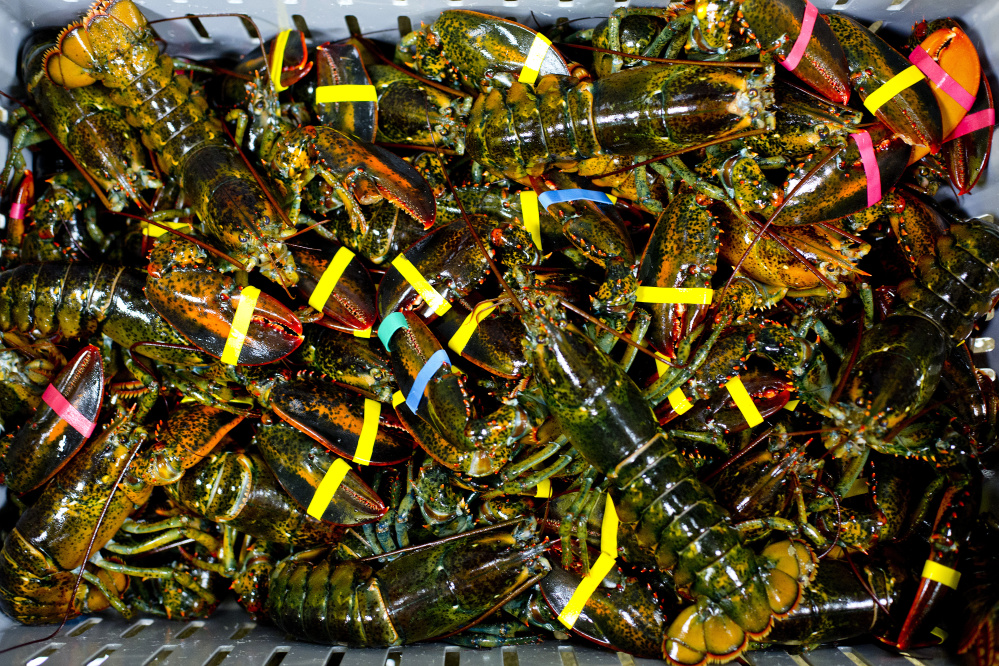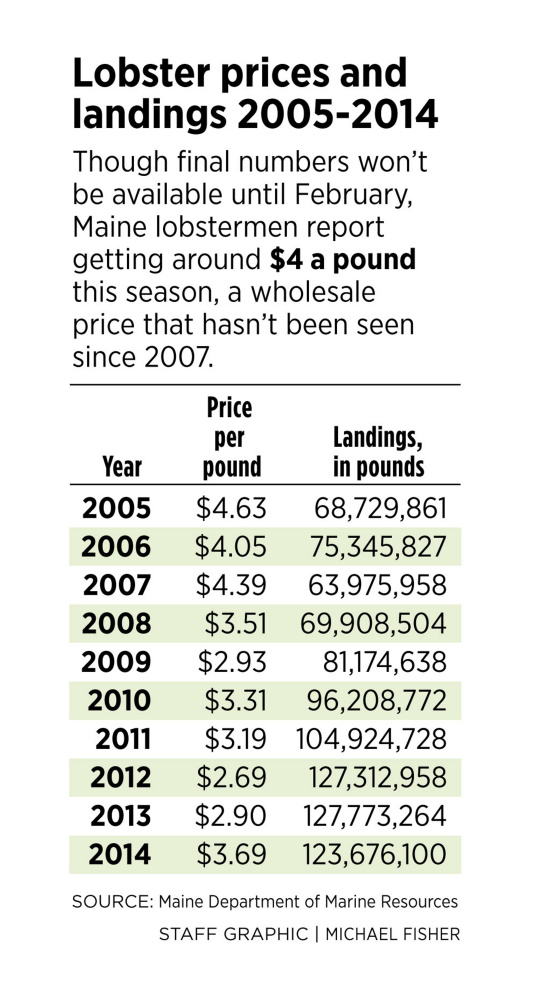Bob Williams has been hauling lobster traps in Penobscot Bay since 1959 and says this year’s season has been among the most profitable ever.
“It’s rare for us to have a fairly good catch and high prices,” said Williams, 78, who lives in Stonington.
It’s a combination that seems to defy the laws of supply and demand – a large catch tends to lower wholesale prices. But that’s not happening this year even with Maine fishermen on track for another huge catch – about four times greater than what was harvested annually from the 1950s through the 1980s.
Industry experts say growing demand for processed lobster meat is allowing the market to absorb the additional catch while maintaining near-record prices paid to fishermen. They also say that Maine’s 4,500 commercial lobstermen, who for the most part fish from July through November, have benefited from some good timing.
The supply of Canadian lobsters available for processors this spring was down because there was so much ice in the Gulf of St. Lawrence that the fishing season was delayed. That means Maine lobsters were in high demand once the season kicked off in mid-July, a couple of weeks behind schedule.
And when the lobsters finally migrated to Maine’s coastal waters to shed their shells, they came at a steady pace rather than all at once.
That’s a lot different from 2012, when lobsters migrated to Maine early en masse, creating a glut in the market and the lowest wholesale price in a generation – $2.69 a pound. Prices improved only a little in 2013 when fishermen harvested a record 127.7 million pounds.
Even though the Maine harvest this year has been unusually strong, fishermen have been hauling in lobsters at a rate that allowed processors to keep pace, said Tim Harkins, president of the Maine Lobster Dealers’ Association.
“This year has been steadier – not the record haul like in other years, just steady,” he said.
Lobstermen are now getting paid around $4 a pound for lobsters – 50 cents to $1 more than they got last year. Prices haven’t been this high since 2007, when the average price paid to fishermen was $4.39.
PROCESSED LOBSTER MEAT IN DEMAND
Demand for lobster has risen because of the growing number of consumers and restaurants using processed lobster meat.
Market prices began rising after Memorial Day as food service companies began preparing more lobster items, such as lobster rolls, for the summer season. Wholesale Canadian claw and knuckle sold for a record of $22.75 a pound on July 31, said Urner Barry, which publishes reports on commodity prices for the food industry.
Landings data are not available for the 2015 season, but industry officials say this year’s harvest will likely be a strong one like last year, when Maine fishermen hauled in 124 million pounds of lobsters. In 2005, when fishermen were paid a record $4.63 a pound, they harvested only 69 million pounds.
Patrice McCarron, executive director of the Maine Lobstermen’s Association, said she has attended meetings with fishermen all along the coast of Maine and reports that fishermen seem quite happy with the way the season is going.
“Everybody has been saying that this is a good year for Maine,” she said.
Fishermen also have benefited from low fuel prices and long stretches of good weather.
THE TALE OF TWO LOBSTER TYPES
But not everyone in the industry is pleased. Some dealers say their margins this year are thinner. While the demand for lobster meat has driven up prices for all lobsters, it’s difficult to pass on that price increase to people buying live lobsters, they say. Retail prices in the Portland area that were around $8 per pound in July are now closer to $6.
Live lobsters and those that are caught for processing come from the same species – Homarus americanus – but they are harvested at different stages of life and are sold in different markets. Hard-shell lobsters, which are rugged and can survive long-distance shipments, are caught by Canadians in the winter and by Maine fishermen in the fall. These lobsters are primarily sold into the live market.
Soft-shell lobsters, now marketed as new-shell lobsters, are harvested in Maine in the summer after lobsters shed their shells, and sold to processors, consumers and restaurants in the Northeast.
Meanwhile, more dealers have entered the market, increasing competition among themselves, said Harkins, who is president of Rocky Coast Lobster in Arrowsic. Maine dealers also are competing with Canadian dealers, who this year stocked their lobster pounds with a large supply of live lobsters.
In recent years, the live market has enjoyed a big boost from China. Maine lobster sales to China jumped from virtually zero in 2007 to $21.5 million in 2014, according to data collected from trade forms that companies fill out for the U.S. Commerce Department.
However, China’s economy slowed this year, and so has its appetite for lobster. Sales this year through July were $9.6 million, down 10 percent from the same period last year.
Dealers in Maine and Canada haven’t sold as many live lobsters to China as they thought they would, said Stephanie Nadeau, owner of the Lobster Co., a wholesaler in Arundel. While dealers have to pay fishermen more for lobsters, she said, dealers can’t mark up their prices because of the additional supply of live lobsters from Canadian pounds and the lower demand from Chinese consumers.
“The dealers are in the middle and are getting squeezed,” she said. “We are miserable, and the fishermen are very happy.”
WORK TO EXPAND MARKET SUCCEEDS
The fishermen are benefiting from the work of dealers and other businesses that have expanded the lobster market and have improved the ways lobsters are processed and shipped, said Annie Tselikis, executive director of the Maine Lobster Dealers’ Association.
Fishermen in New England and Canada’s Maritime provinces are harvesting more than 300 million pounds of lobsters annually, about double the amount they harvested a decade ago, she said. It’s remarkable that the industry has found ways to expand the market, so prices paid to fishermen are now at near-record highs, she said.
“All those lobster have been bought and processed, shipped and sold,” she said. “That’s because of the incredible work of businesses in the supply chain.”
Despite the huge catch in recent years, the lobster population is thriving. The resource is not being overfished, according to an assessment released this summer by the Atlantic States Marine Fisheries Commission.
“The bottom line is we are at or near record abundance levels,” said Carl Wilson, director of the Bureau of Marine Sciences at Maine’s Department of Marine Resources. “There are more lobsters out there, and fishermen are catching a fewer percentage of them.”
CATCHING ALL LOBSTERS, ALL THE TIME
From 1950 to 1989, Maine’s lobster catch ranged from 18 million to 24 million pounds annually. Then the catch began to ramp up in 1990, and surpassed 100 million pounds for the first time in 2011.
In the 1950s and 1960s, fishermen figured they would get 1 pound of lobsters every time they hauled up a trap. Now they haul about 3 pounds per trap, and sometimes more than that, said Williams, of Stonington.
Back then, fishermen also worked in other fisheries, such as groundfish and scallops. Now it’s just lobsters, he said.
For the time being, the focus on a single species is working for Maine fishermen.
Williams’ son, John Williams, 61, harvests lobsters year-round. He said lobstermen this season are making more money than they have in years when they’ve had record catches.
“It’s been an exemplary season,” he said.
Send questions/comments to the editors.





Success. Please wait for the page to reload. If the page does not reload within 5 seconds, please refresh the page.
Enter your email and password to access comments.
Hi, to comment on stories you must . This profile is in addition to your subscription and website login.
Already have a commenting profile? .
Invalid username/password.
Please check your email to confirm and complete your registration.
Only subscribers are eligible to post comments. Please subscribe or login first for digital access. Here’s why.
Use the form below to reset your password. When you've submitted your account email, we will send an email with a reset code.